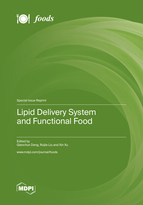Lipid Delivery System and Functional Food
A special issue of Foods (ISSN 2304-8158). This special issue belongs to the section "Nutraceuticals, Functional Foods, and Novel Foods".
Deadline for manuscript submissions: closed (25 January 2023) | Viewed by 38712
Special Issue Editors
Interests: functional food; lipid chemistry and nutrition; colloid chemistry
Interests: lipid chemistry and nutrition; delivery system; biochemical actions of food
Interests: resource development of food functional factors; lipid companion; lipid nutrition and safety; medicinal and edible plant active ingredients
Special Issues, Collections and Topics in MDPI journals
Special Issue Information
Dear Colleagues,
A growing application of lipids and liposoluble ingredients are emerging in functional foods, such as beverages, meal replacement powders, and foods with special medical purpose. Liposoluble ingredients including polyunsaturated fatty acids (PUFA), phytosterols (esters), carotenoids, polyphenols, and liposoluble vitamins, play an important role in balancing the insufficient nutrient intake and occurrence of chronic diseases. However, a critical challenge for their efficient and rational application arises due to the properties of strong hydrophobicity, easy oxidation, unpleasant flavor, and adverse interaction with other components. The construction, perfection, and regulation of lipid delivery system are of great significance for overcoming the challenge. Therefore, this topic mainly collects the following related works:
- The articles collected should describe natural or recombinant delivery system construction (liposomes, emulsions, gels, microcapsules, micelles, etc.) for the purpose of enhancing the physical and chemical stability, bioavailability, bioactivity of active lipids, liposoluble ingredients, as well as flavor maintenance, slow release, etc.. Related content could provide technical support for the development of functional foods.
- Any evaluation methods evaluating the bioactivity and nutritional health effects of lipid delivery systems from cellular and animal levels, as well as multi-omics assays will be welcomed. Articles paying attention to the theoretical basis for the development of functional foods will also be included in this Special Issue.
Prof. Dr. Qianchun Deng
Prof. Dr. Ruijie Liu
Prof. Dr. Xin Xu
Guest Editors
Manuscript Submission Information
Manuscripts should be submitted online at www.mdpi.com by registering and logging in to this website. Once you are registered, click here to go to the submission form. Manuscripts can be submitted until the deadline. All submissions that pass pre-check are peer-reviewed. Accepted papers will be published continuously in the journal (as soon as accepted) and will be listed together on the special issue website. Research articles, review articles as well as short communications are invited. For planned papers, a title and short abstract (about 100 words) can be sent to the Editorial Office for announcement on this website.
Submitted manuscripts should not have been published previously, nor be under consideration for publication elsewhere (except conference proceedings papers). All manuscripts are thoroughly refereed through a single-blind peer-review process. A guide for authors and other relevant information for submission of manuscripts is available on the Instructions for Authors page. Foods is an international peer-reviewed open access semimonthly journal published by MDPI.
Please visit the Instructions for Authors page before submitting a manuscript. The Article Processing Charge (APC) for publication in this open access journal is 2900 CHF (Swiss Francs). Submitted papers should be well formatted and use good English. Authors may use MDPI's English editing service prior to publication or during author revisions.
Keywords
- lipids
- liposoluble ingredients
- delivery system
- biochemical actions
- functional food
- nutritional aspects of food
Benefits of Publishing in a Special Issue
- Ease of navigation: Grouping papers by topic helps scholars navigate broad scope journals more efficiently.
- Greater discoverability: Special Issues support the reach and impact of scientific research. Articles in Special Issues are more discoverable and cited more frequently.
- Expansion of research network: Special Issues facilitate connections among authors, fostering scientific collaborations.
- External promotion: Articles in Special Issues are often promoted through the journal's social media, increasing their visibility.
- Reprint: MDPI Books provides the opportunity to republish successful Special Issues in book format, both online and in print.
Further information on MDPI's Special Issue policies can be found here.







